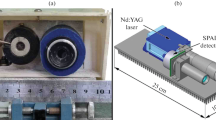The Monte Carlo method is used to solve the nonstationary laser sensing equation for a multicomponent optically dense water medium taking into account the influence of the water-air interface and the contributions of multiple radiation scattering by sea water and of the signal reflection from the sea bottom. Dependences of the signal power recorded with a monostatic lidar equipped with a time-of-flight matrix single-photon avalanche diode (SPAD) photodetector on the water depth and surface microwaves for different field-of-view angles of the receiver are obtained. Results of investigations have shown that the maximum depth of sea bottom detection is 40–50 m given that the optical water thickness does not exceed 3.5–4 m. The dynamic range of lidar signals from water reaches 7–9 orders of magnitude for lidar sensing of sea bottom at limiting depths of 40–50 m in very transparent water in the presence of the Fresnel reflection from the water surface. Results of statistical simulation have shown that the lidar system with the matrix receiver intended for sea water sensing can be realized at the modern technical level. Under favorable conditions, the lidar return signal power provides sensing of sea bottom to depths of 40–50 m.
Similar content being viewed by others
References
K. J. Lee, Y. Park, A. Bunkin, et al., Appl. Opt., 41, No. 3, 401–406 (2000).
K. Fredriksson, B. Galle, K. Nystrom, et al., Underwater laser-radar experiments for bathymetry and fish school detection, Report GJPR-162, Goteborg Inst. Phys. (1978).
V. S. Shamanaev, I. E. Penner, G. P. Kokhanenko, and M. M. Krekova, Nauka-Proizv., No. 9 (65), 20–23 (2003).
V. А. Gladkikh, V. G. Lizogub, G. P. Kokhanenko, and V. S. Shamanaev, Prib. Tekh. Eksp., No. 1, 85–88 (1996).
V. S. Shamanaev, A. I. Potekaev, A. A. Lisenko, and M. G. Krekov, Russ. Phys. J., 59, No. 12, 2034–2040 (2016).
T. J. Petzold, Volume scattering functions for selected ocean waters, SIO Ref. 72–78, Scripps Institute of Oceanography, Visibility Laboratory, San Diego (1972).
Author information
Authors and Affiliations
Corresponding author
Additional information
Translated from Izvestiya Vysshikh Uchebnykh Zavedenii, Fizika, No. 9, pp. 165–170, September, 2019.
Rights and permissions
About this article
Cite this article
Potekaev, A.I., Lisenko, A.A. & Shamanaev, V.S. Statistical Analysis of the Potential of a Bathymetric Lidar with Time-of-Flight Matrix Spad Photodetector. Russ Phys J 62, 1724–1730 (2020). https://doi.org/10.1007/s11182-020-01898-8
Received:
Published:
Issue Date:
DOI: https://doi.org/10.1007/s11182-020-01898-8




